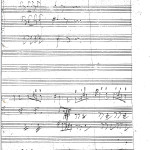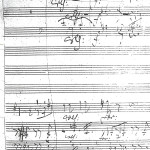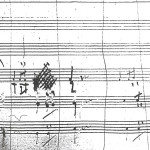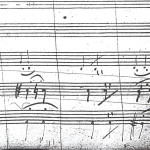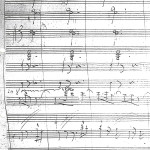A Brief Outline of an important issue encountered in the Beethoven Symphonies
By: David Murphy
The following examples from the autograph manuscript of Beethoven Symphony No. 7 illustrate how concerned Beethoven was about articulation and note lengths. Published scores and parts of the Beethoven symphonies have often been inaccurate on this point: “Striche” (strokes or dashes) frequently being transposed to “Punkte” (dots) or visa versa.
It was extremely important to Beethoven that performers and publishers were accurate with dots and dashes, and inaccuracy in areas such as this was the cause of much “swearing and stamping”.
Figure 1 shows an English translation of the letter to Karl Holtz of August 1825 (quoted in Emily Anderson, The Letters of Beethoven (1961), No. 1421.
Clearly the difference between dots and dashes was very important to Beethoven, so we must be very sure we understand where he intended them to be placed and what he was conveying by their use.
The inaccuracies that caused much “swearing and stamping” have continued to the present day. Figure 2 is a typical example.
Striche (dashes) added to the autograph by Beethoven.
In the continuation see Figure 3 (bars 114-116) and Figure 4 (bars 117-118) note their appearance in flute, oboe and bassoon.
Figure 5 shows how the passage appears in the standard Eulenberg Score (Beethoven’s missing additions inserted in pencil).
Thankfully, the groundbreaking edition of the Beethoven Symphonies by my colleague Jonathan del Mar has improved this situation enormously. Jonathan del Mar, Sir Charles Mackerras and I had very interesting discussions regarding Beethoven’s use of dots and dashes when Sir Charles and I were re-editing Sir Charles’ performance material.
As Jonathan remarks in his preface to the Beethoven Symphony scores,
“…it is nowadays generally agreed that any distinction between the two is only identifiable so sporadically as to be impossible to reflect in a new edition with any degree of logic or consistency”
There are two issues that surface as a result – performers have to go to the original Beethoven sources if they want to make a fully informed decision. Even the most meticulous edition cannot fully convey Beethoven’s intentions. Having made an autograph based decision on whether the composer means a dot or a dash in a particular place and realising that this was important to the composer, one begins to see that the accurate observation of these signs can completely redefine phrase structure and character.
The majority of the time, Beethoven marks dashes rather than dots in his autographs. Until Jonathan del Mar’s edition virtually all scores simply printed a dot regardless of what the composer had written. Now Beethoven’s dashes are again appearing in contemporary editions we have to rediscover their meaning for the composer.
Let’s investigate this further.
Firstly, what did the dash mean to the generation preceding Beethoven? What would young Ludwig have been taught by his musician father Johann?
Leopold Mozart, violinist, teacher, composer and of course father to Wolfgang Amadeus gives us many clues. In his Treatise on the Fundamental Principles of Violin Playing of 1756, the most important string instruction book of the eighteenth century, Leopold writes:
A composer often writes notes which he wishes to be played each with a strongly accented stroke and separated one from another. In such cases he signifies the kind of bowing by means of little strokes which he writes over or under the notes. [See Figure 6](Leopold Mozart A Treatise on the Fundamental Principles of Violin Playing English translation by Editha Knocker page 47)

This is generally how today’s string player would interpret dashes. However, later in the book, in chapter 7 Leopold writes:
Consecutive and continuous rapid notes are subject to many variations. I will here set down a single passage from the first can be played quite smoothly and easily, and in which each note may be performed with its own separate stroke. Great pains must be taken with their exact equality, and the first note of each crotchet must be marked with a vigour which inspires the whole performance. [Figure 7]

He continues:
Now if you wish to accustom yourself to a really long stroke of the bow; if you wish to learn to play notes in one bow, with expression, clarity, and evenness, and therefore make yourself really master of your bow, you can play with great profit this whole passage first in an up stroke, then in a down stroke. But do not forget to apply on the first note of each crotchet the emphasis which must distinguish one crotchet clearly from the other. This is the eleventh variation. [Figure 8]

Now when you are thoroughly practised in slurring so many notes together in one stroke, you must also learn to lift the bow and play several notes detached from each other in one stroke; which gives a twelvth variation. [Figure 9]

In Figures 6-9 we see the dash denoting: accent and separation in Figure 6, emphasis without separation in Figures 7 and 8, and then in Figure 9 something completely different: an off the string stroke which by definition would need a degree of lightness to make it work. Clearly there is far more to this sign than meets the eye…
At this point, we can turn to a source by an important contemporary of Beethoven. The Violinschule by Ludwig Spohr.
Spohr is a vitally important source: he was a close associate of Beethoven and participated in many first performances of Beethoven’s works. Spohr echoes Leopold Mozart: the dash has a variety of meanings:

On p.38 of the Violinschule Spohr writes:
The dashes which in slower music signify the notes are to be short and marked, denote, as used in the following Exercise, that separate strokes are intended, in distinction to slurs.” [See Figure 10]
(Ludwig Spohr, Violinschule, (Cassel, 1832) English edition by Henry Holmes)
So far the dash has meant:
[ordered_list style=”lower-alpha”]
- Marcato
- accented staccato
- an accent under a slur
- lifted staccato
- a simple detached (as opposed to a slurred) stroke
[/ordered_list]
The fact that dashes have a different meaning to dots is emphasised later in the Violinschule, where Spohr uses staccato dots as string players understand them today:
[ordered_list style=”lower-alpha”]
- to separate notes in the same bow, and
- to indicate spiccato, (“off the string” or “staccato leggiero” as Spohr calls it).
[/ordered_list]

His predecessor, Leopold Mozart only uses dots in one context: under a slur [See Figure 11]
It happens also that under the circle or, if the circle be under the notes, over the same, dots are written under or over the notes. This signifies that the notes lying within the slur are not only to be played in one bow-stroke, but must be separated from each other by a slight pressure of the bow.
This is precisely how Beethoven uses dots in the 7th symphony, and the second movement provides a particularly clear illustration of the juxtaposition of dots and dashes: Here is Beethoven’s Autograph of bars 8-112 [see Figure 12] and bars 13-16 [see Figure 13].
These DIFFERENT articulations are vital to the enunciation of the phrase- especially as melody has been dispensed with and only rhythm and harmony are present.
What conclusion can one reach from this preliminary exploration?
A dash often tells one about the importance of a note in the context of other notes: a kind of musical underlining or exclamation mark.
Underlining the importance of a note may be achieved by a variety of means: eg. shorter, simply detached, more accented, louder (even more sustained on occasion) the most natural and musical means depending on the context in which it is used.
I have come to the conclusion that Beethoven in particular will also use the dash as an indication of balance, marking the leading voice with a method that is very simple, and yet very precise and subtle.
In the light of this discussion, one begins to see that we have a huge responsibility to interpret these signs
[ordered_list style=”lower-alpha”]
- accurately ie. only where their use is clearly specified or logically implied and
- musically within the context in which they appear.
[/ordered_list]
As the Strich (dash) usually has a structural function: ie. it signifies a note’s relative importance to other notes, by misreading it as a dot, ignoring it, or superimposing it where its use was not intended, one can easily subvert the structure of a phrase, or even a whole work.
Anyone doubting the importance of this needs only to look at Beethoven’s annotations to the set of parts used for the first performance of the seventh symphony (currently in the Gesellschaft der Musikfreunde, Vienna).

Here are two brief examples of the application of this knowledge [see Figure 14].
Here the dash denotes a sweeping, ringing accent, producing pillars of sound which delineate the two bar phrases. The crotchet lasts about a crotchet: its exact duration and rate of decay defined by the acoustic of the hall. The psychological difference between a staccato dot and a dash is enormous: one takes away duration, the other adds significance.
A slight digression here, but I think an important one whilst we are looking at this opening page of the autograph. Note the alla breve marking. Without access to this manuscript, Schoenberg writes on p.171 of Structural Functions of Harmony (London 1954):
I am convinced that quarter note = 69 is a misprint. Evidently the two episodes on the mediant and submediant (bars 24-34 and 42-52) have a march like character.
He goes on:
Besides, if one of these masters writes sixteenth notes, he means it…
Schoenberg ultimately decided that a tempo of around HALF NOTE = 52 was the most logical, and came to this conclusion on purely structural grounds.
From the same starting point, Gunther Schuller: another probing musical intellect, in his brilliant discussion of the conductor’s art The Compleat Conductor (Oxford 1997) writes about Schoenberg’s intellectually intriguing idea, on p.233. Access to the autograph score (which has only recently resurfaced) with its alla breve time signature makes Schoenberg’s tempo conception even more credible. The autograph is the missing link that means Schoenberg’s theory should be taken very seriously indeed.

Moving on back to the role of dashes, here are bars 9-11 of the First Movement [Figure 15].
Note the placing of the dashes at the beginning of bar 10: beginning on the second sixteenth note signifying the end of one musical paragraph, and the beginning of the next. Also arguably and indication of balance.
In the following extract Beethoven Symphony No. 7, 1st. movement, bars 427-429 [Figure 16] it makes musical sense and it is therefore highly probable, that Beethoven wanted the dashes to be continued throughout this sequence. Here they take on the role of a strong accent: a mere staccato totally loses the sense of syncopation.
Hopefully this brief outline has demonstrated how even two hundred years after their composition there is still much work to be done on the original sources of the Beethoven Symphonies. It is fitting to end with with one of the most controversial: the end of the second movement of the Seventh Symphony has always been a source of disagreement – where exactly did Beethoven intend the violins to move from pizzicato to arco?
This is what Beethoven actually wrote [See Figure 17 and Figure 18].
Problem solved!
With thanks to the Biblioteka Jagiellonska in Krakov, Poland, for access to the Beethoven manuscript, and to Oxford University Press for permission to quote from Leopold Mozart “Treatise on the Fundamental Principles of Violin Playing”

